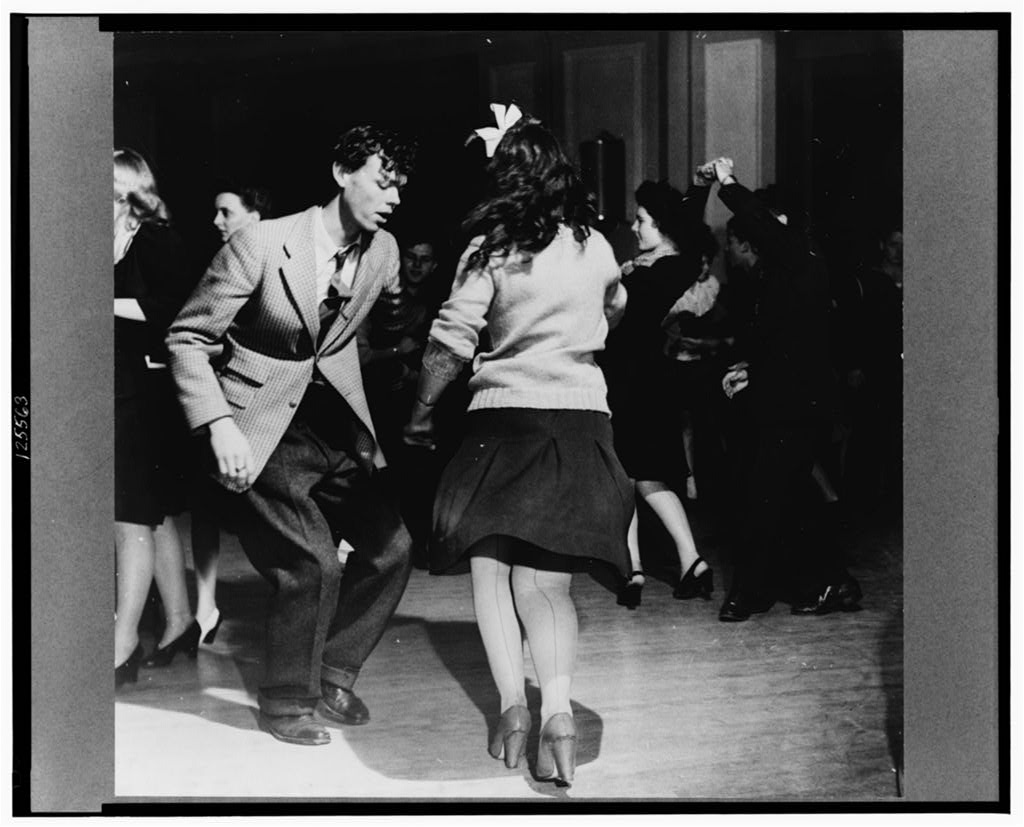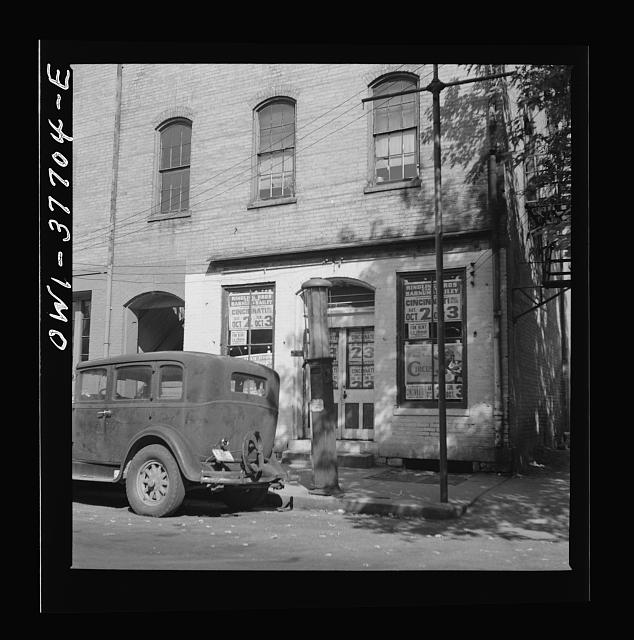In 1943
Esther Bubley took these photos for the
Farm Security Administration. Most come from Washington DC, her home base, but there are many as well from a series of bus trips she took in September. They show changes in daily life brought about by the entry of the U.S. into World War II — men in uniform, women taking over men's jobs, and the like — but they also show things going on as they had before, including the injustices suffered by American Negroes at the time.
There's information about her and her work at the bottom of this page. Except as noted, all photos come from LC's
Prints and Photos Division.
Most of the FSA photographers used 35mm rangefinder cameras such as the famous
Leica III, but Bubley used a
twin lens reflex camera and this accounts both for the innovative use she made of low-angle shots and for the distinctive square images. Hers was not the famous
Rolleiflex, but was almost certainly an
Ikoflex. In 1944
Gordon Parks took a
photo of her with the camera. It's easy to tell it's not a Rollei but it took me quite a while to identify it as an Ikoflex (see images below).
Click images to view full size.
January, Washington DC
{Woman war worker in a woman's boarding house listening to a murder mystery on the radio}

{Detail of this image}
March, Washington DC
{Spectator in the National Gallery of Art on a Sunday afternoon}

{Sitting on the steps of the National Gallery of Art on a Sunday afternoon}

{Members of the congregation during services at the First Wesleyan Methodist church}

{The Campbell family at home after church}

{Detail of this image}

{Detail of this image}
April, Washington DC
{Girl sitting alone in the Sea Grill, a bar and restaurant waiting for a pickup. "I come in here pretty often, sometimes alone, mostly with another girl, we drink beer, and talk, and of course we keep our eyes open--you'd be surprised at how often nice, lonesome soldiers ask Sue, the waitress, to introduce them to us" }

{Detail of this image}

{Jitterbugs at an Elk's Club dance, the "cleanest dance in town" }

{Detail of this image}

{Pin boy at a bowling alley}

{Detail of this image}
May, Washington DC
{Children watching the animals at the National Zoological Park}
June, Washington DC and Arlington VA
{Hattie B. Sheehan, a streetcar conductor for the Capitol Transit Company}

{Benie Lee Neal and Patricia Kaufman are checking the perforated tape at the Western Union telegraph office}

{Arlington, Virginia. Waiting for the bus at Arlington Farms, a residence for women who work in the U.S. government for the duration of the war}

{Arlington, Virginia. Sailors bicycled over to Arlington Farms, a residence for women who work in the U.S. government for the duration of the war, from Washington in search of a date}

{Arlington, Virginia. Women engaged in conversation on a street car}

{Listening to the U.S. Army band play at a free concert in front of the Capitol}

{Detail of this image}
July, Washington DC and Glen Echo MD
{Glen Echo, Maryland. Sun bathers on the sand beach at the swimming pool in the Glen Echo amusement park. Photo shows Claire Bubley in the foreground and Enid Bubley behind her. (Source: Enid Bubley's son, Jerry Raines, 2006). }

{Washington, D.C. Negroes in front of their home, which is an alley dwelling near the capitol}

{Washington, D.C. Negroes in front of their alley dwellings near the capitol}

{Detail of this image}

{Detail of this image}

{Detail of this image}

{Detail of this image}

{Washington, D.C. A worker for the American Rescue Society soliciting funds}

{Detail of this image}
September, bus trips
{A Greyhound bus trip from Louisville, Kentucky, to Memphis, Tennessee, and the terminals. Sign at bus station. Rome, Georgia}

{A Greyhound bus trip from Louisville, Kentucky, to Memphis, Tennessee, and the terminals. Waiting for the bus at the Memphis terminal}

{Detail of this image}

{A Greyhound bus trip from Louisville, Kentucky, to Memphis, Tennessee, and the terminals}

{Detail of this image}

{Street scene in a town in Ohio}

{A rest stop for Greyhound bus passengers on the way from Louisville, Kentucky, to Nashville, Tennessee, with separate accommodations for colored passengers}

{A Greyhound bus trip from Louisville, Kentucky, to Memphis, Tennessee, and the terminals. Men sitting by road side on Sunday afternoon, between Memphis and Chattanooga}

{Passengers on a Greyhound bus going from Chicago, Illinois to Cincinnati, Ohio. Most of the standing passengers are local fares going from their farms to town}

{Bus trip from Knoxville, Tennessee, to Washington, D.C. Schoolgirl waiting to get on bus at small town in Tennessee}

{Bus trip from Knoxville, Tennessee, to Washington, D.C. Schoolgirl waiting to get on bus at small town in Tennessee}

{ Pittsburgh, Pennsylvania. Passengers in the waiting room of the Greyhound bus terminal}

{A Greyhound bus trip from Louisville, Kentucky, to Memphis, Tennessee, and the terminals. Passengers standing in aisles on Memphis-Chattanooga Greyhound bus}

{Detail of this image}

{A Greyhound bus trip from Louisville, Kentucky, to Memphis, Tennessee, and the terminals. Waiting for a bus at the Memphis station}

{A Greyhound bus trip from Louisville, Kentucky, to Memphis, Tennessee, and the terminals}

{A Greyhound bus trip from Louisville, Kentucky, to Memphis, Tennessee, and the terminals. Hailing a Macon-bound bus on the highway in Georgia}

{A Greyhound bus trip from Louisville, Kentucky, to Memphis, Tennessee, and the terminals. Small boy waiting for the bus at Chattanooga.}
October, Washington DC
{Students entering the building at Woodrow Wilson High School}

{Feet of a student at Woodrow Wilson High School}

{Algebra students at Woodrow Wilson High School}

{Listening to the teacher's instructions in a physical education class at Woodrow Wilson High School}

{Watching a football game}
December, Washington DC
{Lynn Massman, wife of a second class petty officer who is studying in Washington, cooking dinner}

{A sailor getting some help in wrapping his Christmas gifts at the United Nations service center}

{A picture-taking machine in the lobby at the United Nations service center}

{Detail of this image}

{Detail of this image}
About Esther Bubley
{Esther Bubley, self-portrait c. 1950}

{This shot shows her Ikoflex camera and her flash technique; ca. 1945; source: flickr}

{Esther Bubley at Bayway Oil Refinery, by Gordon Parks, December 1944}

{Esther Bubley with her Ikoflex iii 853/16; photo by John Vachon, 1944; source: flickr}
LC had a web page from an exhibit by
ESTHER BUBLEY. It says:
Military and political events overseas were not the only subjects reporters and photographers covered during World War II. Photographer Esther Bubley (b. 1921) found ample subject matter to explore on the American homefront as the nation mobilized for war.
Twenty-year-old Bubley arrived in Washington, D.C., in 1941, fresh from art school and a short stint with Vogue and eager to earn a living with her camera. Although she soon found work as a lab technician at the National Archives, Bubley's ambition was to work for Roy Stryker. Stryker, head of the documentary photography project of the Historical Section, Farm Security Administration (FSA) Documentary Photo project from 1935 to 1943, was an outstanding mentor and teacher, who attracted young photographers to work for him.
During her off-hours, Bubley set out to prove her camera skills by snapping wartime subjects around the nation's capital. Her unvarnished images of life in the city's boarding houses for war workers impressed Stryker enough to recruit the aspiring photographer into the Office of War Information (OWI), where the Historical Section had been relocated.
OWI sent Bubley on at least one cross-country bus trip, during which she produced hundreds of images of a country in transition from the doldrums of the Great Depression to the fevered pace of war. Unlike many of her colleagues, however, Bubley was not drawn to the awesome industrial complex spawned by the war, preferring instead to focus on average Americans. "Put me down with people, and it's just overwhelming," Bubley said of her focus on the human dimension of mobilization.
About Bubley, see also:
Esther Bubley: American Photo-Journalist
Esther Bubley, photojournalist
Esther Bubley: Techniques and Equipment
More photos of Esther Bubley on flickr
Ikoflex images:

{Ikoflex III (853/16). This camera has a distinctive Albanda finder and the shape of the lens mount is unique. It was produced 1939-40. The operating lens is a Tessar 2.8 in Compur-Rapid. Source of these images: pacificrimcamera

{Ikoflex image from an eBay auction}
About the Ikoflex:More images and a 1939 advertisement:
Ikoflex III 853/16A flickr page on the camera:
Ikoflex III 853/16





































































No comments:
Post a Comment